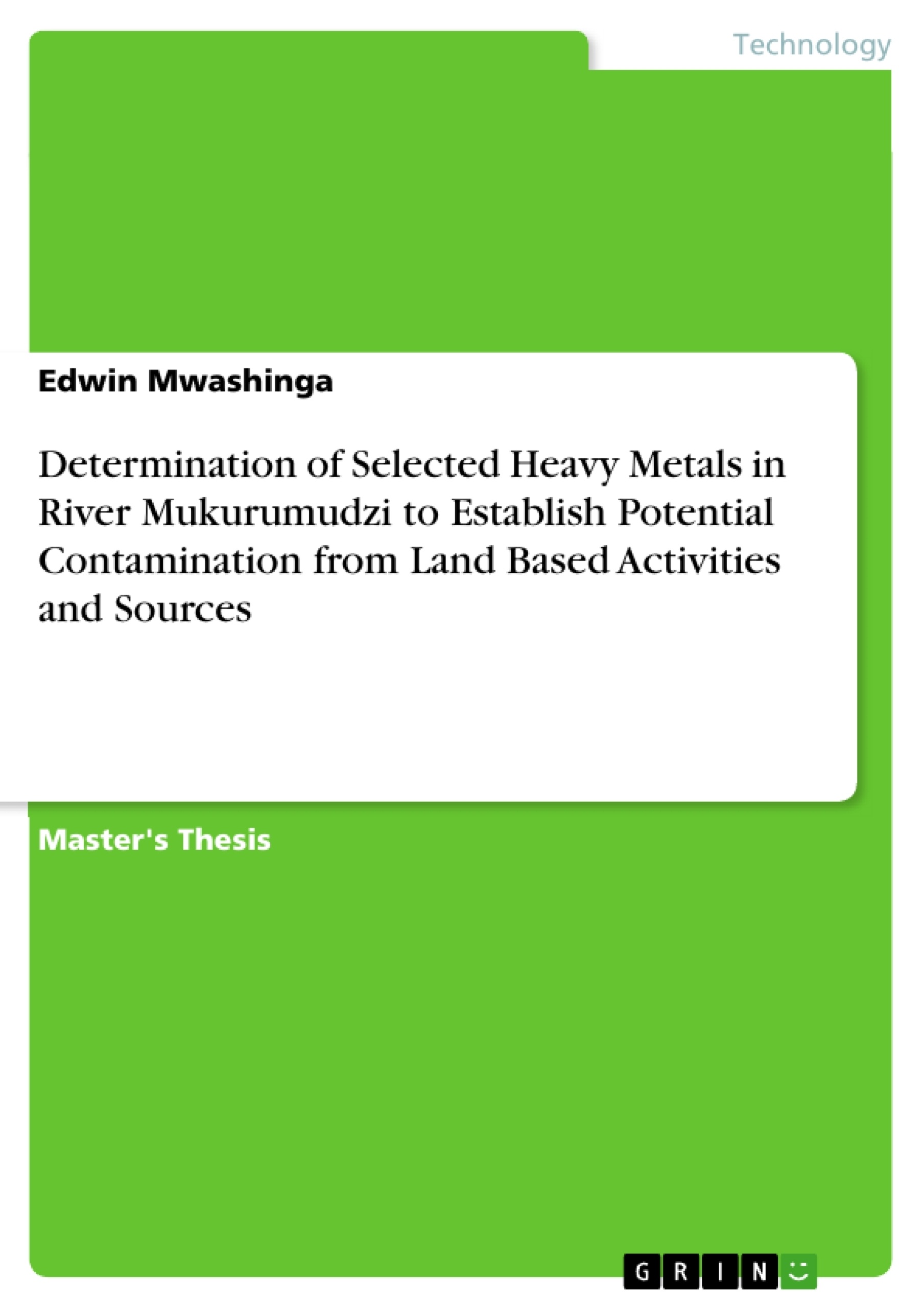Rivers are the major sources of water being used in cities and its environs. This water may either be treated or untreated. River banks could be very busy, varied activities ranging from farming to industrial activities and other domestic household activities are conducted. The present study aimed at investigating the potential sources of selected heavy metal contaminants in River Mukurumudzi, Kwale County. Water and sediments were sampled in four points along the river impacted by mining, human settlements and agricultural activities for three different seasons. The samples were analyzed for Iron, Lead, Cadmium, Copper and Arsenic using an AAS. Sediment quality was also analysed by the calculation of CF and I-geo values. Interpretation of results was conducted using Minitab statistical software and Excel spreadsheets. The range of metals in water during the dry season was Fe (0.19-0.32) mg/l, Pb, Cu, Cd and As were below the detection limits. The range of metals in water during the short rain was Fe (0.12-1.25) mg/l and BDL for all other analysed metals. The range of metals in water during the long rain season was Fe (0.07-1.82) mg/l, Cu (0.08-0.11) mg/l and BDL for all the other analysed metals. The range of metals in sediments during dry season was Fe (0.13-1.44) ppm, Pb (0.08-0.54) ppm, and BDL for all other analysed metals. The range of metals in sediments during short rain season was Fe (0.23-1.73) ppm, Pb (0.12-0.27) ppm, and BDL for all other analysed metals. The range of metals in sediments during the long rain season was Fe (0.25-2.75) ppm, Pb (0.09-0.34) ppm, Cu (0.10-0.14) ppm, and BDL for all other analysed metals. The CF values for sediments were all <1 which indicated low contamination. The I-geo values of metals in sediments were all <1 suggesting the sediments are practically unpolluted. The concentrations of metals in water were all within the NEMA, KEBS and WHO limits thereby indicating non-contamination. River Mukurumdzi water and sediments are not contaminated by heavy metals. However, there is need for the land-based activities to be assessed since elevation of metal concentration was observed during the rainy seasons because of run-off from these sources.
KEY WORDS: Heavy metals, AAS, BDL, Sediments and Water contamination, I-geo and CF
Inhaltsverzeichnis (Table of Contents)
- CHAPTER ONE.
- INTRODUCTION.
- 1.1 Background Information.......
- 1.2 Statement of the problem
- 1.3 Objectives.
- 1.3.1 Research Questions.
- 1.3.2 Research Hypothesis.......
- 1.4 Justification……………………..\li>
- 1.5 Scope of study and limitation.
- 1.5.1 Scope of Study............
- 1.5.2 Limitation of the study.
- 1.6 Assumptions of the study...
- CHAPTER TWO.
- LITERATURE REVIEW.
- 2.1 Introduction
- 2.2 Rivers and Pollution from Land Based Activities.
- 2.3 Heavy metal and pollution.
- 2.4 Sources of Heavy metal pollution
- 2.5 Heavy metals and water pollution
- 2.6 Heavy metals in Sediments......
- 2.7 Heavy Metal pollution in Kenya.
- 2.8 Kwale County and River Mukurumudzi
- CHAPTER 3
- MATERIALS AND METHODS
- 3.1 Introduction
- 3.2 Description of study area..\li>
- 3.3 Methodology......
- 3.3.1 Sampling procedure..\li>
- 3.3.2 Data collection approach.
- 3.3.3 Data Collection Techniques
- 3.3.4 Validity and reliability of research instruments.
- 3.3.5 Data Analysis and presentation.....
- 3.3.6 Validation of results.
- CHAPTER FOUR...
- RESULTS AND DISCUSSION.
- 4.1 Heavy metals in water
- 4.2 Heavy metals in sediments
- 4.3 Comparisons of heavy metals.
- 4.3.1 Correlations between heavy metals..\li>
- 4.3.2 ANOVA Comparisons of heavy metal concentrations between sites
- 4.4 Water Contamination ..
- 4.5 Sediments Contamination
- 4.5.1 Geo-accumulation Index results.
- 4.5.2 Contamination Factor (CF) results.
- CONCLUSIONS AND RECOMMENDATIONS.
- 5.1 Conclusions
- 5.2 Recommendations
Zielsetzung und Themenschwerpunkte (Objectives and Key Themes)
The study aims to determine the levels of selected heavy metals in River Mukurumudzi and establish potential contamination from land-based activities. The research investigates the concentration of heavy metals in both water and sediment samples, examining the potential sources of contamination and the impact on the river's ecosystem.
- Assessment of Heavy Metal Contamination in River Mukurumudzi
- Identification of Sources of Heavy Metal Pollution
- Evaluation of the Impact of Heavy Metal Contamination on the River Ecosystem
- Exploration of Potential Health Risks Associated with Heavy Metal Pollution
- Recommendations for Mitigating Heavy Metal Contamination in the River
Zusammenfassung der Kapitel (Chapter Summaries)
Chapter One provides an introduction to the research, outlining the background information, the problem statement, objectives, research questions, hypothesis, justification, scope of study, limitations, and assumptions. Chapter Two reviews relevant literature related to rivers, pollution from land-based activities, heavy metals, sources of heavy metal pollution, water pollution, heavy metals in sediments, heavy metal pollution in Kenya, and the study area. Chapter Three describes the materials and methods employed in the study, including the study area, sampling procedure, data collection approach, data analysis, and validation of results.
Schlüsselwörter (Keywords)
This study focuses on the determination of selected heavy metals in River Mukurumudzi, aiming to identify potential contamination from land-based activities. Key themes include heavy metal pollution, water contamination, sediment contamination, river ecosystems, health risks, and environmental management. The research utilizes methods such as sampling, analysis, and statistical comparisons to assess the levels of heavy metals and determine the extent of contamination in the river.
- Quote paper
- Edwin Mwashinga (Author), 2018, Determination of Selected Heavy Metals in River Mukurumudzi to Establish Potential Contamination from Land Based Activities and Sources, Munich, GRIN Verlag, https://www.grin.com/document/424220



